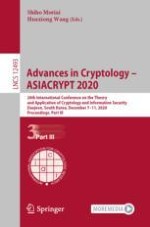2020 | OriginalPaper | Buchkapitel
Adaptively Secure Inner Product Encryption from LWE
verfasst von : Shuichi Katsumata, Ryo Nishimaki, Shota Yamada, Takashi Yamakawa
Erschienen in: Advances in Cryptology – ASIACRYPT 2020
Aktivieren Sie unsere intelligente Suche, um passende Fachinhalte oder Patente zu finden.
Wählen Sie Textabschnitte aus um mit Künstlicher Intelligenz passenden Patente zu finden. powered by
Markieren Sie Textabschnitte, um KI-gestützt weitere passende Inhalte zu finden. powered by
